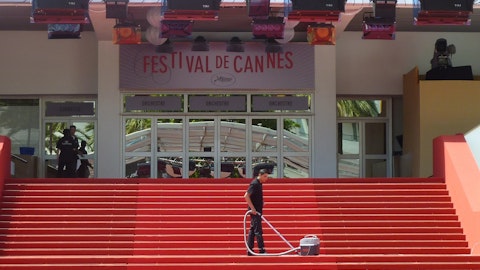Earl Ellis : No, absolutely. Let’s put it this way. We feel really good about our strong cash flow. And if you look at this quarter, which Q1 is typically the lowest net cash flow quarter of the year. When we look at the full year, we anticipate still on pace to deliver the $240 million to $270 million of cash flow, excluding kind of like Elevate and integration costs. And that combined with our relatively low leverage ratio, we’ve finished the quarter at 2.4, just outside of kind of like the low end of our range. So we feel really good with the capabilities that we actually have to continue to do opportunistic share buybacks if that case weren’t. At a minimum, we’ll be doing kind of like the anti-diluted buybacks in the next quarter or so.
Jasper Bibb: Got it. Last one for me, I just wanted to ask about the EV business, you’ve had really good growth there. The last couple of years, but message this year being a bit more flat with just like a slower rollout to customers, you’ve seen any change there as far as the pipeline or just the tenor of client conversations in the EV business?
Scott Salmirs: Yes, look, it’s been a little slower than we would have liked, but we were focused on, and this is maybe old news because we’ve talked about it, we’ve been focused on the dealer side, dealership of car dealerships, and that slowed down a bit, and we’re gravitating more towards fleet, bigger scale projects, and it just does take time, right? But like in terms of EV sentiment and where we’re going, we still are so enthusiastic about where this will be over the next few years because you read some of the headlines about the feelings of pulling back, but the addressable market is massive, it’s still happening, and it’s where the future is, so we’re kind of rebooting, and have been in the process of rebooting our strategy towards larger fleet projects, so I think that’s going to manifest itself over time, and I suspect, ‘25 will be stronger than ‘24, and ‘26 will be stronger than ‘25, but it’s been a slow roll for us because of the fact that the dealerships have definitely pulled back a little bit, so, but we, make no mistake, we feel like we picked the right swim lane when we think about EV and its future.
Operator: Our next question comes from the line of David Silver with CL King.
David Silver: Yes. Hi. Thank you. Good morning. My first question, I’d have a couple of things maybe to ask about the Technical Solutions this quarter. So you have discussed it, but I guess I was just kind of wondering why the margins weren’t just a little bit stronger this period. In other words, you did mention closeouts on a number of microgrid projects. And I don’t know, my understanding is when you close something out, you resolve some contingencies, and a certain amount of incremental profit can get released with the closeout. And then maybe bigger picture but with the closeouts and with the big new contract that you signed. I’m thinking about the earnout or the total compensation that or sorry incentive compensation that ABM may be responsible for this year.
So I do believe the targets are EBITDA based and last year there were some adjustments for a lower EBITDA outcome than envisioned in the original agreement, purchase agreement. So could you just maybe touch on maybe the first thing with the closeouts and the profit impact of that? And then secondly what’s the outlook for the RavenVolt unit hitting or exceeding that EBITDA threshold for a larger earnout? Thank you.
Scott Salmirs: Sure. So look, yes, you’re right. We talked about this a little bit a few minutes ago but it’s the same thing. This is really a function of the mix of business and timing of the project so the reason that you saw a little pressure on the margin on the ATS segment was that the mix of work this quarter was such that it was a lower margin segment of the business and don’t forget we still have continued pressure on our bundled energy solutions project because of interest rates so for us David there’s no warning signs as it relates to ATS, RavenVolt been growing like unbelievably if you think about kind of where they were when we did the acquisition versus where they are today with their pipeline and how we believe they’re going to finish the year.




